#Advanced Nuclear Reactors
Explore tagged Tumblr posts
Text
Ask A Genius 1416: Quantum Hollywood, AI Job Displacement, and the Risks of Nuclear Innovation
Rick Rosner is an accomplished television writer with credits on shows like Jimmy Kimmel Live!, Crank Yankers, and The Man Show. Over his career, he has earned multiple Writers Guild Award nominations—winning one—and an Emmy nomination. Rosner holds a broad academic background, graduating with the equivalent of eight majors. Based in Los Angeles, he continues to write and develop ideas while…
0 notes
Text
Molten Salt Reactor (MSR) Market Overview and Upcoming Trends 2032

Overview of the Molten Salt Reactor Market:
Global Molten Salt Reactors market is projected to grow at a CAGR of 5.9% by 2032.
The Molten Salt Reactor (MSR) Market revolves around the development, deployment, and commercialization of nuclear reactors that use molten salt as both fuel and coolant. MSR technology offers unique advantages, including enhanced safety, reduced nuclear waste, efficient fuel utilization, and the potential to operate on a variety of fuel types. The market is driven by the growing interest in advanced nuclear energy solutions that address safety concerns, waste management, and sustainable energy production.
Molten Salt Reactors (MSRs) are a type of advanced nuclear reactor technology that use a liquid mixture of salts as both the fuel and the coolant. MSRs offer several potential advantages, including increased safety, reduced nuclear waste, and the ability to efficiently use thorium as a fuel source. The MSR market has gained attention as a potential solution for addressing energy needs while minimizing environmental impacts.
Scope:
Advanced Reactor Technology: MSRs represent a novel approach to nuclear power generation, utilizing liquid fuel instead of solid fuel rods. The scope includes research, development, and commercialization of MSR designs.
Fuel Flexibility: MSRs can utilize a range of fuels, including thorium and enriched uranium, which expands the scope to exploring alternative fuel cycles for efficient energy production and reduced nuclear waste.
Nuclear Waste Reduction: The inherent design of MSRs can potentially reduce the long-lived nuclear waste compared to conventional reactors, making MSR technology part of waste management solutions.
Safety Features: MSRs offer passive safety mechanisms, including negative temperature coefficients and natural circulation of the molten fuel, which enhances reactor safety.
Thorium Fuel Cycle: The scope includes exploring the potential of thorium as a fuel source in MSRs, as it is more abundant and potentially safer compared to traditional uranium fuel.
Energy Generation: MSRs have potential applications in electricity generation, process heat production, and even hydrogen production, expanding the scope to various industrial sectors.
Research and Development: The scope encompasses ongoing research and development efforts to optimize MSR designs, improve fuel cycle efficiency, and enhance safety features.
Demand:
Clean Energy Generation: Growing demand for clean and low-carbon energy sources to address climate change and reduce greenhouse gas emissions drives interest in advanced nuclear technologies like MSRs.
Nuclear Power Resurgence: The MSR's potential to overcome some limitations of traditional reactors, such as safety concerns and nuclear waste issues, aligns with the global interest in reviving and advancing nuclear power.
Energy Security: MSRs offer a stable and reliable energy source that can contribute to energy security and grid stability, particularly in regions with limited access to traditional energy resources.
Industrial Applications: The high-temperature output of MSRs can be used for industrial processes, such as hydrogen production and desalination, driving demand for efficient and versatile energy solutions.
Opportunities:
Innovation in Nuclear Technology: The development of MSR technology presents opportunities for innovation in reactor design, materials science, and fuel cycle optimization.
Waste Management Solutions: MSRs' potential to reduce nuclear waste and utilize existing waste as fuel offers opportunities for addressing the long-term challenges of nuclear waste disposal.
Energy Transition: MSRs can be a bridge between conventional energy sources and a more sustainable future, presenting opportunities in the global transition to cleaner energy systems.
Collaboration and Investment: Opportunities exist for collaboration between governments, research institutions, and private sector companies to advance MSR technology through funding, expertise, and resources.
Energy Export and Security: Countries with advanced MSR technology can potentially export clean and safe nuclear energy solutions, enhancing energy security and international partnerships.
Nuclear Industry Revival: The development and deployment of MSRs can contribute to a revitalized nuclear industry by addressing public concerns, safety issues, and waste management challenges.
We recommend referring our Stringent datalytics firm, industry publications, and websites that specialize in providing market reports. These sources often offer comprehensive analysis, market trends, growth forecasts, competitive landscape, and other valuable insights into this market.
By visiting our website or contacting us directly, you can explore the availability of specific reports related to this market. These reports often require a purchase or subscription, but we provide comprehensive and in-depth information that can be valuable for businesses, investors, and individuals interested in this market.
“Remember to look for recent reports to ensure you have the most current and relevant information.”
Click Here, To Get Free Sample Report: https://stringentdatalytics.com/sample-request/molten-salt-reactor-market/12100/
Market Segmentations:
Global Molten Salt Reactor Market: By Company
• MAN Energy Solutions
• Kairos Power
• Enesoon Holding
• Copenhagen Atomics
• Terrestrial Energy
• Moltex Energy
• ThorCon Power
• Elysium Industries
• Transatomic
• Flibe Energy
• Lightbridge
• Shanghai TaiYang Technology Co.,Ltd
Global Molten Salt Reactor Market: By Type
• Thorium
• Plutonium
• Uranium
Global Molten Salt Reactor Market: By Application
• Oil and Gas
• Power and Energy
• Shipping
• Others
Global Molten Salt Reactor Market: Regional Analysis
The regional analysis of the global Molten Salt Reactor market provides insights into the market's performance across different regions of the world. The analysis is based on recent and future trends and includes market forecast for the prediction period. The countries covered in the regional analysis of the Molten Salt Reactor market report are as follows:
North America: The North America region includes the U.S., Canada, and Mexico. The U.S. is the largest market for Molten Salt Reactor in this region, followed by Canada and Mexico. The market growth in this region is primarily driven by the presence of key market players and the increasing demand for the product.
Europe: The Europe region includes Germany, France, U.K., Russia, Italy, Spain, Turkey, Netherlands, Switzerland, Belgium, and Rest of Europe. Germany is the largest market for Molten Salt Reactor in this region, followed by the U.K. and France. The market growth in this region is driven by the increasing demand for the product in the automotive and aerospace sectors.
Asia-Pacific: The Asia-Pacific region includes Singapore, Malaysia, Australia, Thailand, Indonesia, Philippines, China, Japan, India, South Korea, and Rest of Asia-Pacific. China is the largest market for Molten Salt Reactor in this region, followed by Japan and India. The market growth in this region is driven by the increasing adoption of the product in various end-use industries, such as automotive, aerospace, and construction.
Middle East and Africa: The Middle East and Africa region includes Saudi Arabia, U.A.E, South Africa, Egypt, Israel, and Rest of Middle East and Africa. The market growth in this region is driven by the increasing demand for the product in the aerospace and defense sectors.
South America: The South America region includes Argentina, Brazil, and Rest of South America. Brazil is the largest market for Molten Salt Reactor in this region, followed by Argentina. The market growth in this region is primarily driven by the increasing demand for the product in the automotive sector.
Visit Report Page for More Details: https://stringentdatalytics.com/reports/molten-salt-reactor-market/12100/
Reasons to Purchase Molten Salt Reactor Market Report:
• To gain insights into market trends and dynamics: this reports provide valuable insights into industry trends and dynamics, including market size, growth rates, and key drivers and challenges.
• To identify key players and competitors: this research reports can help businesses identify key players and competitors in their industry, including their market share, strategies, and strengths and weaknesses.
• To understand consumer behavior: this research reports can provide valuable insights into consumer behavior, including their preferences, purchasing habits, and demographics.
• To evaluate market opportunities: this research reports can help businesses evaluate market opportunities, including potential new products or services, new markets, and emerging trends.
• To make informed business decisions: this research reports provide businesses with data-driven insights that can help them make informed business decisions, including strategic planning, product development, and marketing and advertising strategies.
About US:
Stringent Datalytics offers both custom and syndicated market research reports. Custom market research reports are tailored to a specific client's needs and requirements. These reports provide unique insights into a particular industry or market segment and can help businesses make informed decisions about their strategies and operations.
Syndicated market research reports, on the other hand, are pre-existing reports that are available for purchase by multiple clients. These reports are often produced on a regular basis, such as annually or quarterly, and cover a broad range of industries and market segments. Syndicated reports provide clients with insights into industry trends, market sizes, and competitive landscapes. By offering both custom and syndicated reports, Stringent Datalytics can provide clients with a range of market research solutions that can be customized to their specific needs.
Contact US:
Stringent Datalytics
Contact No - +1 346 666 6655
Email Id - [email protected]
Web - https://stringentdatalytics.com/
#Molten Salt Reactor#MSR Technology#Advanced Nuclear Reactors#Nuclear Energy Innovation#Sustainable Energy Solutions#Clean Energy Generation#Nuclear Power Resurgence#Fuel Flexibility#Nuclear Waste Reduction#Thorium Fuel Cycle#Energy Security#Industrial Applications#Nuclear Research and Development#Passive Safety Features#Energy Transition#Nuclear Industry Revival#MSR Design#Energy Generation Technologies#Nuclear Waste Management#Nuclear Fuel Cycle#Renewable Energy Alternatives#Sustainable Nuclear Power.
0 notes
Text

Big news for fans of arguing with your sibling
#nuclear#nuclear energy#nuclear power#atomic power#atomic energy#advanced reactors#nuclear reactors#nuclear reactor
5 notes
·
View notes
Text
Small Modular Nuclear Reactors Could Spark Big Change in Michigan Energy Future
Michigan may soon be at the forefront of nuclear innovation thanks to bipartisan legislation supporting small modular reactor development. Michigan Energy Policy Takes a Leap Toward Nuclear Innovation State Rep. Jamie Thompson State Rep. Jamie Thompson is leading a bipartisan push to bring small modular nuclear reactors (SMRs) to the forefront of Michigan’s energy future. On Tuesday, the House…
0 notes
Text
Ironically, Fatalis would probably be the only horror that would be well within his comprehension. He'd just sit there like "oh, so it's like a natural Zoh Shia. That's terrifying but like, it makes sense. That's probably what Zoh Shia was based on."
Now, show him something like say, Amatsu or the storm serpents, and he'll probably go "Whoa, so they show up when the weather becomes inclement, like the apexes?"
"Oh no they make the weather like that. By themselves."
"They fucking what-"
Man learning about the rest of the Monster Hunter world must give Nata anxiety. Like bro comes from a place where killing a Chatacabra is considered a feat of great strength and killing a Rathalos variant is akin to bringing down a demigod, and then the rest of the world is like "Sigh. Went out for a swim and a Lagiacrus electrocuted me. Gotta go hire a Hunter to kill it." A bunch of Doshaguma is considered a near-apocalyptic event to a Forbidden Lands village when Old World villages don't even consider an evacuation unless an Elder Dragon is almost on top of them. And don't even get started on Kamura, where there's so many monsters swarming the place sometimes everyone there has at least a provisionary hunter license. The dogs are trained to use ninjitsu. The average villager knows how to wall-run. Even the fucking dango vendor has a machine gun and two dozen confirmed large monster kills to her name.
#'it took an entire impossibly advanced organic nuclear reactor to be able to change the weather in my homeland.'#'What the FUCK do you mean this giant terrifying flying snake can just... DO THAT on its own?!?'#you tell this kid about valstrax he's never getting on an airship again also
747 notes
·
View notes
Text
youtube
#iter#east#nuclearfusion#nuclearfission#ChinaInnovation#NuclearFusion#CleanEnergyRevolution#EASTExperiment#FutureEnergy#HotterThanTheSun#ScienceBreakthrough#ITERCollaboration#SeawaterMagic#EnergyRevolution#SustainablePower#TechInnovation#GlobalCollaboration#RenewableFuture#GreenTechLeadership#general knowledge in tamil#gk on board#gkonboard#general knowledge#nuclear fusion#nuclear fission#tokamak reactor#doughnut reactor#Experimental Advanced Superconducting Tokamak#deuterium#China
0 notes
Text
#food#i'm a microwave meal girlie tbh#my hands are too weak to peel stuff so i use a shun board to make decent food on occasion#i prioritize time so i try to get the most nutrition for the least amount of time spent
1K notes
·
View notes
Text

Obsolete Manipulator, Dragon Reactor, Winfrith, 2023
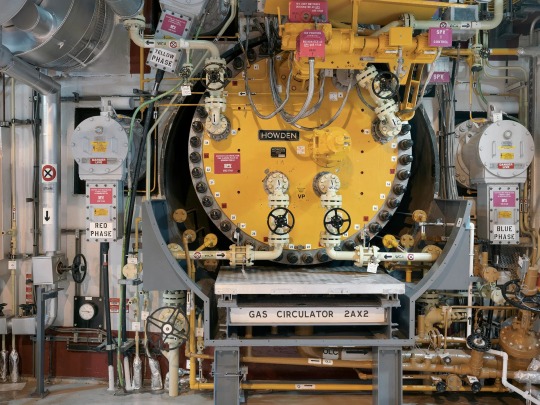
Gas Circulator, Advanced Gas-Cooled Reactor, Torness, 2023
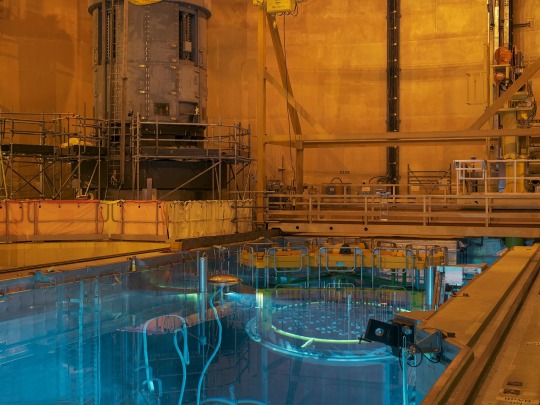
Refuelling Cavity, Reactor Sizewell B, No 2, 2023

Window No 10, Irradiated Fuel Cave Dounreay Prototype Fast Reactor, 2023
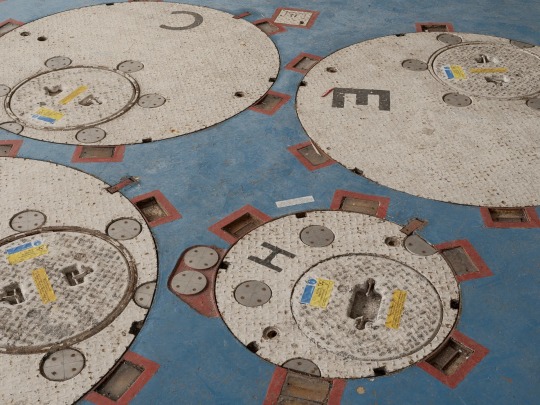
Pile Cap Detail, Reactor 2, Dungeness A, No 1, 2022
The Nuclear Sublime photographs by Michael Collins published by RRB Photobooks, Bristol, UK 'Documenting infrastructure spanning a period of seven decades, the photographs in The Nuclear Sublime depict the present state and future of Britain’s nuclear industry— usually hidden from public view' image credits: Michael Collins via: The Guardian
2K notes
·
View notes
Text


(EPFL Swiss Plasma Center)
Tokamak à Configuration Variable, or TCV, is a Swiss research fusion reactor with an extremely elongated (tall and narrow) plasma vessel and a ton of independently controlled poloidal magnetic coils (orange, in the figure above). As the name implies, this means that it can shape fusion plasma into a wide variety of intricate configurations. TCV's ability to "sculpt" plasma has been instrumental in a ton of discoveries in nuclear fusion.
Negative triangularity (where the usual "D" shaped plasma points backwards, with the flat side facing out and the curve pointing to the center of the machine) is particularly interesting, as it allows for high confinement without a fluctuating plasma edge. Also a ton of advanced divertor geometries, like the snowflake divertor. Here are a few examples:

anyway,
330 notes
·
View notes
Text




First post in a while. I have since made many things, but for now have my Godzilla work. The First King of the Monsters, The original Godzilla. He first rose from the depths in 1954. He suffered great pain from the nuclear bomb testing's in Bikini Atoll. He took his pain and wrath out on the people of Japan, or any unfortunate neough to find themselves at sea in his territory. He terrorized Japan for years, occasionally battling off other gargantuan monstrosities in his time, before his inevitable demise. He was killed by the Oxygen Destroyer, a super weapon created by the late doctor Daisuke Serizawa, who took his own life after destroying his work on the Oxygen destroyer to keep it from being recreated.




The Second King of the Monsters, Godzilla Though Godzilla perished in the 70's with the first and only ever use of the Oxygen Destroyer, his offspring survived. Godzilla Sr.'s offspring, simply called Godzilla during his time, had taken to his mutations much more easily than his father. Though he was born in his current form, and his body had adapted to its current form so he lived without pain, he knew the ones responsible for leaving him alone, without his father. In 1985, this Godzilla surfaced to unleash his own fury on Japan. Tho he was still destructive, after a few years he settled into life on Infant Island, and only came to Japan when he felt his territory was endangered. He died when his internal nuclear reactor had a melt down, irradiating all of Infant Island.



The Prince of the Monsters, Godzilla Junior The current Godzilla, and son of the previous. It's unknown where he, or his father, came from, but his presence on Infant Island was known prior to Godzilla's death. The radiation from his Father's death empowered him, allowing him to grow into a more powerful form. Jr. is notably more agile and faster than his father and grandfather were, having adapted perfectly to his new form. His atomic breath is also considerably more powerful than both of his predecessors. Unlike his family, Jr. never grew to hate humanity. Though he does not go out of his way for the express purpose of saving man kind, he doesn't actively seek its destruction.




The Golden Demise, King Ghidorah. A three headed alien from an unknown planet. He ofund his way to the Solar System landing on Venus. He eradicated all life on the planet, draining the energy from all of the beings on the planet, before moving on to the next planet, Earth. King Ghidorah however did not expect the planet to be crawling with other, equally large, equally deadly monsters, and often found himself unable to drain the life from Earth. Most often he would face either Mothra or Godzilla, the pair eventually forcing him to flee back into space, before Godzilla's death. Once he has absorbed enough energy, he plans to return to Earth and finally wipe out all life on the Planet.








Multi-Puprose Fighting System 3, Mecha Godzilla With the ever rising presence of giant monsters across the world, the people of Earth came together with a plan to deal with them. The UN formed the AMF, Anti Megalosaurus Force. This military force was made to combat any and all giant monsters that appear, when they appear. The AMF, using state of the art tech, advanced computers, and the bones of the original Godzilla as a base to work off of, created the Multi-Purpose fighting System 3, or Mecha Godzilla. It is piloted by a single person remotely. Mecha Godzilla comes with numerous armaments. On its right arm is a pair of rail guns. The base structure of the rail guns can also extend an electrically charged blade. The left arm comes equipped with the most powerful Maser Cannon ever built. Mounted on either shoulder is a more recently created weapon, high power twin plasma cannons, designed with the purpose of burning through hardened shells. Finally, the most powerful of Mecha Godzilla's abilities is dubbed the Proton Scream, a beam fired from the mouth with enough power put into it to slice many monsters clean in half. This ability is rarely used due to the amount of power it consumes. Though the machine has no life nor will of it's own, many of maintenance crew believe it to be haunted, often making reports of it moving, or activating on its own. One particular report from an engineer claims that Mecha Godzilla came online and watched the Engineer as they worked. These reports are unsubstantiated and assumed to be untrue.



Type 1 Maser Tank The original Maser Tanks invented in the late 60's to deter Godzilla Senior prior to his death. The technology has improved considerably since then, with modern Maser Tanks having a minimum power output nearly double the maximum of the Type 1's.

Size comp of Mecha-G, Ghidorah, Sr., Goji, and Jr.
371 notes
·
View notes
Text
Tony Stark’s achievements
Childhood:

“Brilliant and unique mind”
At age 4 built his first circuit board
At age 6 built his first engine
Cracked the Pentagon’s firewall in high school on a dare
Went to college at 14
Built cool smart robots (Dum-E and U) when he was a teen
At 17 graduated summa cum laude from MIT
Polyglot
Before Afghanistan:

“Da Vinci of our time”
Became an owner and CEO of Stark Industries at 21
Successfully ran the company for decades
Advanced the world of technology, not only in weaponry and robotics but also:
created advanced AI J.A.R.V.I.S.
created holographic interface technology
created repulsor technology
Participated in charity
In and after Afghanistan:

“I’m sorry, I’m not Tony Stark”
Survived an open-heart surgery in a cave, without general anesthesia
Lived with, in fact, a debilitating wound, shrapnel, and a huge and dangerous technological device in his body for years and was willing and capable of doing not only his usual work but also being a superhero and doing all these next things...
Did not give up under torture and fought with his captors
Invented and built a miniaturized Arc Reactor, in a cave, with a box of scraps
Invented and built Iron Man armor, in the same cave, with the same box of scraps
Escaped from captivity by himself (with help from Yinsen, but without any armed assistance)
Became an expert in piloting and driving
Saved people in Gulmira
Saved a USAF pilot
Probably the best hacker in the world, was able to easily hack networks of the Pentagon, US government, AIM, and SHIELD
Fought with Iron Monger after nearly died. Defeated him and saved many lives. Was ready to die for that
Built many more different Iron Man armors
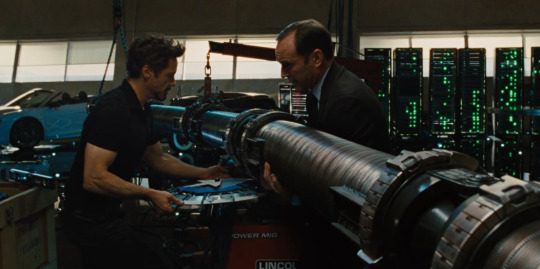
Fought terrorists between IM and IM2 (IM2 tie-in comics)
Saved a submarine crew (IM2 - newspapers in Vanko’s home)
Saved a woman from a fire (IM2 - newspapers in Vanko’s home)
“Stabilized East-West relations” (IM2 - newspapers in Vanko’s home), so the world was “enjoying its longest period of uninterrupted peace in years”
Organized Stark Expo
Was able to keep Iron Man armor in his safe hands despite the government’s and HYDRA’s attempts to take it for themselves
Defeated Ivan Vanko in Monaco
(Re)Discovered a new element
Synthesized it, by building a particle accelerator, at home
Revolutionized energy industry and science. Gave clean energy to the world
Defeated Vanko in New York with Rhodey, Natasha, and Pepper and saved many lives again
Saved Peter Parker (IM2)
Made it so that the Abomination would not leave prison and join the Avengers

Built Stark/Avengers Tower powered by Arc Reactor technology
Saved Steve Rogers and many civilians in Germany from Loki
Was able to fight with Thor on equal terms
Biggest brain on Earth, arguably - in the Universe:
best scientist on the team, in SHIELD, on Earth, in the Universe
expert in nuclear, particle, and quantum physics
was able to learn very quickly – became an expert in thermonuclear astrophysics in one night
Successfully tracked Tesseract by its gamma radiation with Bruce
Saved Helicarrier with the Avengers and SHIELD agents on board, almost died
Saved Rogers from a merc right after that
Fought with Chitauri, killed many of them, saved a lot of people
Was able to blow up a Leviathan by himself
Saved New York City by redirecting a nuke to the wormhole
Saved the world by destroying Thanos’ Chitauri army, almost died again
Founded The United States Department of Damage Control to clean up after battles
Rebuilt Stark Tower into Avengers Tower and gave each team member their own quarters

One of the best biologists and biomedical engineers on Earth, even if it’s not his main area of expertise:
helped Maya with Extremis back in 1999, because knew more in her own field, and even didn’t remember that
was head hunted by Aldrich Killian to work on Extremis with/instead of Maya, who was the leading expert in tissue regeneration
improved and stabilized Extremis, so it became safe regenerative technology, and with it…
cured Pepper
healed extensive injuries in his chest
invented and implanted devices for remote control of his suits (into his forearm in IM3, and most probably into his brain for Mark L armor in Infinity War)
invented build-in diagnostic system in his suits
Invented many devices for protection purposes (ex. bomb disposal)
A capable detective. Figured out the cause of explosions in IM3 on his own
Saved Pepper instead of himself by putting Mark 42 on her during the attack on his Malibu mansion
Survived the attack with a barely working prototype suit. Shot down a helicopter with a piano
Was able to fight with enhanced fire-breathing regenerating terrorists without armor and weapons in Rose Hill. In handcuffs
Knowledgeable and skilled in medicine:
saved a kid with his arc reactor in a deleted scene from IM3, selflessly pulling it out of his chest and performing defibrillation under electric shocks
knew how to recognize hyperglycemia when Harley was eating 3rd bawl of candies
closed his wound in Infinity War with nanoparticles
performed first-aid on Bruce after his snap
Built a lot of stuff from random things he bought in a store for the assault on the Mandarin's mansion. In a motel
Successfully stormed the Mandarin's mansion full of armed and huge security guys with dogs. Alone. Without his armor
Successfully escaped captivity in the Mandarin's mansion with just a few pieces of armor on
Saved all the people who fell from the Air Force One
Stormed Roxxon Norco ship with Rhodey, without a suit. With one handgun
Saved the US president
Defeated Killian and his Extremis-enhanced terrorists, saved many lives

Built quinjets
Created Iron Legion
Became the benefactor of the Avengers, provided them with everything, was a combatant, and also the team’s pilot, hacker, engineer, medic, and scientist
As an Avenger saved many lives on missions, including destroying the rest of HYDRA in AoU
With Bruce’s help created Veronica and Hulkbuster suit
Defeated a rogue Iron Legionnaire with a fork
In contrast to other team members was able to function after Wanda played with his mind
Defeated mad Hulk. Saved a lot of lives in Johannesburg
Easily hacked nuclear codes in Nexus and found J.A.R.V.I.S. “in the world’s biggest haystack”
Created advanced AI F.R.I.D.A.Y.
Many advanced AIs
Created Vision
With the Avengers defeated Ultron and his army
Evacuated people who were left in Sokovia
Saved a falling evacuation shuttle with people on it
Together with Thor saved Earth by destroying the falling Sokovia
Rebuilt Stark Compound into Avengers Compound for the team in Upstate New York

Invented several medical devices, including leg braces, blood toxicity detector
Sponsored the development of technology for psychotherapy (B.A.R.F.). Prevented it from being used for harm
Funded all the students’ projects at MIT
Did everything possible to legally, politically, and physically protect the team before, during, and after the Civil War
Was able to disarm Winter Soldier without a suit, with only one armored glove
Figured out Spider-Man’s identity
Created Spider-Man’s suits

Mentored, sponsored, and looked after Peter Parker
Saved Peter Parker (SMH). Twice
Saved the ferry from sinking
Invented nanoparticles
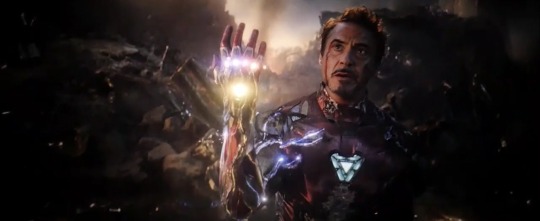
“Earth’s best defender”
Went to space to save Peter, Strange and bring back Time Stone
Saved Peter Parker (IW)
Saved Strange on the Donut spaceship. Killed Ebony Maw
Cloak of Levitation chose him as his second favorite (deleted scene with Tony wearing Levi and Strange in Mark L)
Was respected by Thanos himself
Withstood when Thanos hit him with a moon
Fought Thanos, made him bleed, kept fighting even without armor
Survived a severe injury thanks to his own invention
Was able to function, tried to fix Benatar, and return home while injured and ill with an infected wound
Built a lab for Bruce and helped him to become one with Hulk (combine the best of both worlds)
Became an amazing dad
Became an expert in time travel physics
Discovered/invented (controlled) Time travel
Built a time machine
Went on Time Heist and stole Tesseract from a guarded military base
Created his own Infinity Gauntlet
Thus brought half of the universe back to existence (Bruce snapped and partially sacrificed his health, but nothing would be possible without Tony)
Saved Bruce’s arm by providing emergency medical care
Fought with Thanos again and…
Saved the whole Universe

#tony stark#iron man#mcu#marvel#the avengers#avengers endgame#captain america civil war#avengers age of ultron#iron man 2#iron man 3#spider man homecoming#avengers infinity war
971 notes
·
View notes
Text
The devastation of nuclear colonialism, which permanently destroys Indigenous communities throughout the world, is outright ignored by some of the most devout climate justice advocates. They claim nuclear energy production is also a green solution to the climate crisis. More than 15,000 abandoned uranium mines are located within the so-called US, mostly in and around Indigenous communities, permanently poisoning sacred lands and waters with little to no action being taken to clean up their deadly toxic legacy. There are currently ninety-three operating nuclear reactors in the so-called US that supply 20% of the country’s electricity. There are 60,000 tons of highly radioactive spent nuclear waste stored in concrete dams at nuclear power plants throughout the country with the waste increasing at a rate of 2,000 tons per year. In 1987 the “US” Congress initiated a controversial project to transport and store almost all of the US’s toxic waste at Yucca Mountain located about 100 miles northwest of so-called Las Vegas, Nevada. Yucca Mountain has been held holy to the Paiute and Western Shoshone Nations since time immemorial. In January 2010 the Obama administration approved a $54 billion taxpayer loan in a guarantee program for new nuclear reactor construction, three times what Bush previously promised in 2005. In April 2022, the Biden administration announced a $6 billion government bailout to “rescue” nuclear power plants at risk of closing. A colonial government representative stated, “US nuclear power plants contribute more than half of our carbon-free electricity, and President Biden is committed to keeping these plants active to reach our clean energy goals.” They, along with Climate Justice activists cite nuclear energy as necessary to combat global warming, all while ignoring the devastating permanent impacts Indigenous Peoples have faced. There is nothing clean about energy produced from nuclear colonialism. From its weapons (including depleted uranium) to its mining and its waste; Indigenous bodies, lands, and waters continue to be sacrificed to heat water with radioactive materials which creates steam that moves generators to charge batteries made from lithium extracted from other Indigenous sacred lands so Teslas can move you forward into a “just” climate future. A green economy sustains and advances colonial progress, which means mitigated selective and ongoing destruction of Mother Earth.
Klee Benally - No Spiritual Surrender: Indigenous Anarchy In Defense of the Sacred
210 notes
·
View notes
Text
Ghouls are, put simply, humans suffering from advanced, prolonged radiation sickness and whose bodies have mutated such that gamma radiation extends their lifespan past natural limits.
The process of ghoulification is outlined in canon sources, but I wanted to make a guide that goes into more detail on the effects of radiation sickness in various cases, since the level and type of exposure significantly affects the outcome.
This is the first in what will be a series of posts exploring both real-life cases of radiation sickness and the sci-fi concept of ghoulification in some depth. Graphic descriptions of the physical deterioration of the body are included for informative purposes; reader discretion is advised.
For this first case study, I examine the effects on the human body of exposure to high levels of radiation in a short period of time, with a focus on the real case of Hisashi Ouchi.
On September 30, 1999, a lack of appropriate safety measures and the proper materials resulted in an accident that caused three workers at the nuclear power plant in Tōkai-mura, Japan, to suffer from severe radiation poisoning while purifying reactor fuel.
Point of Criticality
An uncontrolled fission reaction was produced when technicians poured nearly seven times the legal limit of uranium oxide into an improper vessel containing nitric acid. The men reported seeing a bright blue flash—indicative of Cherenkov radiation—when the mixture reached critical mass, flooding the room with radiation. The workers evacuated to the decontamination room, but already, the two who had been handling the reactive solution were overcome with intense pain from radiation burns, severe nausea, and difficulty breathing. Hisashi Ouchi, who suffered the highest level of exposure, also experienced rapid difficulties with mobility and coherence. Upon reaching the decontamination room, he vomited and fell unconscious.
~1 Hour Post-Exposure
Ouchi regained consciousness in the hospital about 70 minutes after the criticality accident, where doctors confirmed that he had been exposed to high doses of gamma, neutron, and other radiation.
The maximum allowable annual dose of radiation for nuclear technicians in Japan was 50 millisieverts. Exposure to more than 7 sieverts is considered fatal. Yutaka Yokokawa, the supervisor, had received 3 sieverts. The technicians who had been handling the uranium, Masato Shinohara and Hisashi Ouchi, received 10 sieverts and 17 sieverts, respectively.
~1 Day+ Post-Exposure
During the first few days in the ICU, Ouchi appeared to be in remarkably good condition, given the circumstances: the skin of his face and right hand was slightly red, as if by a sunburn, and swollen. His eyes were bloodshot, and he reported pain under his ear and right hand, which had received the most direct exposure, but he could speak normally, and he joked with the doctors and nurses attending to him.
6 Days Post-Exposure
Tests revealed that the high energy radiation that Ouchi had been exposed to had obliterated the chromosomes in his bone marrow. They were unrecognizable—some severed, some fused, all out of order. This damage meant that his body was unable to create new blood cells. The red blood cells that transport oxygen could not be replaced, and Ouchi's white blood cell count was near zero, leaving him extremely vulnerable to infection.
~1 Week+ Post-Exposure
Intensive treatments, including numerous skin grafts, blood and bone marrow transfusions, and revolutionary stem cell transplants were conducted in an attempt to stabilize Ouchi, but ultimately without lasting success.
The skin grafts couldn't hold; when medical tape was peeled from his skin, his skin came with it, and the marks left behind couldn't heal. Blisters like those of a burn appeared on his right hand.
Ouchi reported frequently that he was thirsty.
~10 Days Post-Exposure
By this point, Ouchi's oxygen levels were so low that even speaking required tremendous effort. Ouchi was placed on supplemental oxygen and required sedatives to be able to sleep.
2 Weeks+ Post-Exposure
Ouchi was no longer able to eat and required an IV. By day sixteen, most of the skin on the front side of his body had fallen off.
His low platelet count and lack of healthy skin meant that his blood and bodily fluids leaked through his damaged pores, resulting in unstable blood pressure.
Donor stem cells that were meant to allow his body to create new tissue were also destroyed by the radiation present in his body.
~1 Month Post-Exposure
On the 27th day following the accident, Ouchi suffered from intense diarrhea. The mucus layer of his large intestine had vanished, exposing the red submucosal layer beneath. His body could no longer disgest or absorb anything he ingested; even water was excreted as diarrhea.
The skin of Ouchi's right hand was almost entirely gone, leaving the surface of his hand raw and dark red. Blisters spread across his right arm and abdomen, then over his entire body. Gauze was required to replace his skin, and his fingers had to be individually wrapped to prevent them from sticking together. Without skin to keep him warm, Ouchi required an electrothermic device to maintain his body temperature while his bandages were changed—a daily procedure that took hours. Every time the gauze was removed, more of Ouchi's remaining skin went with it. His eyelids could not shut, and his eyes bled. His nails fell off.
Ouchi's right arm was necrotizing, leading to an increasing amount of myoglobin—a protein in muscle tissue—flowing in Ouchi's blood. Untreated, this could result in renal failure as the kidneys could not process the amount of myoglobin present.
Ouchi's body could not regenerate the platelets that form scabs, meaning the risk of hemorrhage was extreme.
By day 50, more than two liters of fluid seeped from Ouchi's damaged skin each day. The amount of fluid prevented skin grafts from adhering. Furthermore, he began to suffer from blood in his stool, and permeated blood seeped between his inflamed small and large intestines.
2 Months+ Post-Exposure
On the 59th day after the accident, Ouchi suffered the first of many heart attacks. His kidneys and liver were also failing. He no longer showed reactions to stimuli.
By day 63, Ouchi's macrophages—the immune cells that normally attack and consume bacteria and viruses—were attacking his own healthy blood cells.
After 67 days, Ouchi suffered internal hemorrhage. He bled from his mouth and intestines.
Ouchi would continue to suffer from heart attacks, as many as three in one hour. Each time, he was revived, but he suffered increasing brain damage, until multiple organ failure ended his life after 83 days in the hospital.
Ouchi's colleague Masato Shinohara underwent numerous successful skin grafts and a stem cell transfusion as well as radical cancer treatment, but he, too, died of multiple organ failure after seven months. Their supervisor, Yutaka Yokokawa, was treated for minor radiation sickness and was released from the hospital within three months of the accident.
This detailed chronology was referenced from the book A Slow Death: 83 Days of Radiation Sickness by Iwanami Shoten, translated by Maho Harada. My post, of course, focuses on Ouchi's physical condition in his final months, but it’s important to remember him not just as a victim or a patient. He was a loving husband and father whose sense of humor and resilience left an impression on everyone he came into contact with. The book is available in its entirety here and provides a moving, nuanced account of the incident and the efforts to save Ouchi's life.
453 notes
·
View notes
Text
An innovative algorithm for detecting collisions of high-speed particles within nuclear fusion reactors has been developed, inspired by technologies used to determine whether bullets hit targets in video games. This advancement enables rapid predictions of collisions, significantly enhancing the stability and design efficiency of future fusion reactors. Professor Eisung Yoon and his research team in the Department of Nuclear Engineering at UNIST announced that they have successfully developed a collision detection algorithm capable of quickly identifying collision points of high-speed particles within virtual fusion devices. The research is published in the journal Computer Physics Communications.
Continue Reading.
67 notes
·
View notes
Text
Several groups representing “startup nations”—tech hubs exempt from the taxes and regulations that apply to the countries where they are located—are drafting Congressional legislation to create “freedom cities” in the US that would be similarly free from certain federal laws, WIRED has learned.
According to interviews and presentations viewed by WIRED, the goal of these cities would be to have places where anti-aging clinical trials, nuclear reactor startups, and building construction can proceed without having to get prior approval from agencies like the Food and Drug Administration, the Nuclear Regulatory Commission, and the Environmental Protection Agency.
Trey Goff, the chief of staff of the startup nation known as Próspera, tells WIRED that he and other Próspera representatives working under an advocacy group called the Freedom Cities Coalition have been meeting with the Trump administration about the idea in recent weeks. He claims the administration has been very receptive. In 2023, Trump floated the idea of creating 10 freedom cities. Now, Goff says that Próspera’s vision is to create “not just 10, but as many as the market can handle.” They hope to have drafted legislation ready by the end of the year.
“The energy in DC is absolutely electric,” Goff says. “You can tell in meetings with the people involved that they have the mandate to do some of the more hyperbolic, verbose things Trump has mentioned.”


Three Paths Forward
According to Goff, Freedom Cities Coalition has briefed White House officials on three options for creating freedom cities. One is through “interstate compacts.” In this scenario, two or more states could set aside territories with shared tax and regulation policies, with some state-specific carve-outs. Under existing law, these compacts can’t be revoked, though they can be dissolved under certain circumstances.
If an interstate compact is approved by Congress, it becomes valid under federal law. Goff says the coalition is considering Congressional legislation that would give “advanced consent” to any freedom city compacts. That way, Congress wouldn’t need to approve each individual city.
Two other options are creating federal enclaves with special economic and jurisdictional zones, or having Trump issue executive orders to create each new freedom city.
“It depends on what Trump and the White House want to do,” Goff says. “Whatever pathway they want to take, we want to help them make that a reality.”
The White House did not respond to a request for comment from WIRED.
A Network of Backers (and Detractors)
Freedom Cities Coalition was created by an entity called NeWay Capital LLC, which owns several trademarks for Próspera. Since opening on the Honduran island of Roatán in 2020, Próspera has been attracting tech workers and startups by promising low taxes, few regulations, and a businesslike government that considers its citizens to be akin to customers. Its financiers include Pronomos Capital, a venture capital firm backed by Peter Thiel and Marc Andreessen, and Coinbase.
Startup nations outside the US have largely relied on the creation of special economic zones (SEZs), where the regular rules governing businesses are waived, often in order to attract foreign investment. The hope, it appears, is to bring a similar model to the US.
Notably, the current government of Honduras considers Próspera and its special economic status to be illegal. The country’s previous president, Juan Orlando Hernández, gave Próspera a permanent charter to operate on its own terms. However, many Honduran citizens opposed Próspera, arguing that it has increased poverty and worsened biodiversity in the area. The Honduran Congress passed a law in 2022 repealing the allowance of SEZs, and Próspera sued the Honduran government shortly after. The lawsuit is ongoing.
President Donad Trump mentioned the idea of freedom cities on the campaign trail in March 2023. He promised that if he was elected president, he would hold a contest to pick 10 winners to build their own freedom cities on federal land. Trump hasn’t referred to the idea in public since, but Goff says he’s confident that it wasn’t a throwaway line from the president.
“It’s not just a marketing tactic—they take it very literally,” Goff adds, referring to members of Trump’s team. “They intend to follow through with all of the promises they made on the campaign trail.”
A Second Legislative Push
Freedom Cities Coalition isn’t the only group currently lobbying the Trump administration. Frontier Foundation, a 501c4 organization, is working in partnership with the nonprofit Charter Cities Institute to bring freedom cities to the US.
Jeffrey Mason, the head of policy at the Charter Cities Institute, tells WIRED that several other groups have recently joined their effort, including the Housing Center at the American Enterprise Institute and the Foundation for American Innovation. They’re drafting legislation that Mason says should be ready “hopefully sometime in the next several months.”
He adds that members of these groups are having “casual conversations with people in the White House,” in addition to Republican and Democratic members of Congress.
In a 2025 memo shared with WIRED, the Frontier Foundation argues that “domestic innovation and production has been significantly impeded for decades by outdated and unnecessarily restrictive federal regulation.”
Allen tells WIRED that using federal land would lower the cost of development for startup cities. The Frontier Foundation suggests that federally owned land outside western cities like Boise, Idaho; Grand Junction, Colorado; and Redmond, Oregon would be suitable candidates. “If we're able to get a legislative transfer of land from the US government to make a public-private partnership, or a trust, or even a private corporation, then it's a lower cost of capital,” he explains.
The Frontier Foundation memo also recommends allowing private landowners to become freedom cities and to “allow municipalities to vote to become Freedom Cities, allow Freedom Cities to expand with the consent of the contiguous land owners.”
When asked why the Freedom Cities movement has chosen not to focus on revitalizing existing post-industrial cities like Detroit or Toledo, Ohio, Allen tells WIRED that “when you're building these new facilities, you need to sort of start from scratch.” He noted that Joe Biden signed an executive order instructing the federal departments to lease federal lands to be used as data centers in the final days of his administration.
“There's so much capital and there's so much political will, but yet there's an inability to develop these technologies,” says Allen. “And the inability comes from lack of space and too many regulations.”
But Gil Duran, a former political consultant and author of the Substack newsletter Nerd Reich, warns that building new cities from scratch could have negative consequences. “To be outside of the law and above the law, what does that mean for the rest of the country?” he asks. “It seems like you're going to start hollowing out other places in order to have these places where the rules are suspended and don't apply anymore to certain people.”
Goff says that unlike Próspera, which has an entirely different tax structure from surrounding Honduras, freedom cities in the US would likely pay a similar amount in state and federal taxes as other American cities. The main difference would be how the cities are regulated.
American Dynamism
One company that stands to benefit from the rise of freedom cities is Minicircle, a longevity biotech company focused on developing gene therapies to extend human lifespans. The company’s seed funding came from Thiel and OpenAI CEO Sam Altman, and it currently has offices in both Austin, Texas, and Próspera. Minicircle cofounder Mac Davis is also working with the Frontier Foundation.
Davis says that Minicircle’s gene therapy clinical trial on the protein follistatin—which he claims increases muscle mass without side effects, and also has life-extending benefits in mice—was only possible in Próspera, but noted he’d like to see that change.
“I'd like a ‘longevity city’ where everyone and their dog is on gene therapy,” Davis says.
Davis adds that he can imagine many other companies benefiting from freedom cities, including SpaceX, the defense hardware and software company Anduril, and Oklo, a nuclear fission startup chaired by Sam Altman.
Many of the industries Allen says he hopes to foster in Freedom Cities–energy, nuclear, semiconductors, and defense technology–are, not coincidentally, ones “a lot of venture [capital] is going towards” as funding moves away from SaaS, digital, and internet consumer brands.
“The theme is American Dynamism,” he says, referencing the 2022 manifesto from venture capital firm Andreessen Horowitz, which argues that “the scientific and operational excellence of consequential technology companies made up for the shortfall of our flailing governmental institutions.” Since 2021, venture capitalists have plowed more than $100 billion into defense tech startups alone.
Some tech companies have been considering revitalizing nuclear power in order to sustain AI data centers, which use a huge amount of energy. Amazon signed several nuclear power agreements last year, Google made a deal with a nuclear power company in October 2024, and Meta is asking for proposals on how the company can leverage nuclear power.
Goff tells WIRED that he thinks freedom cities could also be used as manufacturing hubs and shipbuilding ports, allowing builders to bypass the environmental review process. Mason says the American Enterprise Institute, which is partnering with the Frontier Foundation and Charter Cities Institute, is eager to find ways to use freedom cities to increase housing.
Mason says he’s most excited about speeding up innovation in sectors like biotech and using nuclear power to power AI data centers.
“There's a lot of exciting opportunities here, especially as we need a lot of data centers,” Mason says. “There's a lot of land that you can tap.”
But Duran says that the same deregulation that could be seen as pro-business will likely not favor those outside Freedom Cities’ ultrawealthy backers. “These are going to be cities without democracy,” he claims. “These are going to be cities without workers' rights. These are going to be cities where the owners of the city, the corporations, the billionaires have all the power and everyone else has no power. That's what's so attractive about these sovereign entities to these people, is that they will actually be anti-freedom cities.”
55 notes
·
View notes
Text
Ignition
Once the Galactic Coalition had (without other realistic options) given Humanity an equal position among the governing bodies, despite the fact they were a single planet race, the initial dread of what they would do eased. A little. When they showed how they powered their impossibly massive vessels, the fears of our ancestors who deemed the Responsibility Barrier a necessity reemerged a thousandfold.
The Humans, with a slight grin, said "Solar power, of course."
They took a delegation within the bowels of one of their smaller, civilian research craft, which was still bulkier, better armored, and more worryingly - better armed than most flagships of the other predator-races. Were we not able to see with our own eyes their actual, what they aptly call, Dreadnoughts, from distances you would normally need a telescope, we would have assumed this was their mightiest warship. Yet it was just one of hundreds.
As we passed through the ludicrously thick and seemingly excessive number of bulkheads and shielded and compartmentalized hallways, the ever present hum of raw power beneath our feet gradually became nerve-wracking. What is that? It reminded us of stories told by those who traveled near Black Holes - of the sheer vastness and infinite apathy they felt from the all consuming entities.
A dozen or so biometric gates later, we were greeted by a gigantic sphere, easily a hundred and fifty meters in diameter, an abomination of reinforced panels, wiring, heat pumps, and countless tubes, hanging from numerous power conduits in the middle of an even more massive chamber from behind our observation platform. A true, pure fusion reactor. And there were Humans, in full protective suits at least, working directly next to it within the ominous chamber.
"We wanted to give you a demonstration of our advances in the past millennia, so please observe as we turn on this one."
This one? As in... the power we were feeling was not from this monstrosity? We had to ask.
"Oh, of course not, this ship has three such reactors, we recently performed a full maintenance on this and decided to delay reactivating it for you to see."
The delegates' mouths (or equivalents) were agape. Sure, nuclear fusion is known far and wide, but due to it's high potential for cataclysmic failure, or worse, deliberate destruction, the vast majority of such reactors were mostly found in deep space stations where solar radiation was scarce. Background radiation converters, while efficient at what they do, were nowhere sufficient enough for anything more than as passive emergency battery chargers. And no civilization kept fusion reactors anywhere near populated or colonizeable planets.
Yet here they were, looking at one nearly five times larger than any other known or attempted. And there were three on this ship alone. They counted hundreds of similar size, a few dozen of their Dreadnoughts, thousands of smaller vessels ferrying between the stations, the surface, and other larger ships. Countless world ending bombs-in-waiting right around the Humans' only home.
"Yeah, us science ships get the biggest ones, kinda need the extra oomph for our projects. The military kids like their redundancies, so theirs are smaller."
A slight relief.
"I think their newest capital ship, the UGSF Caliban of York, has fifteen, each about half ours."
A few delegates passed out. Their attendants rushed to salvage some dignity, but Captain Knoslark of this vessel, The Radiant Dusk at Everest, didn't seem surprised or offended and simply waited for the delegation to regain composure before continuing.
"This is my favorite part."
He said quietly with a glint in his eyes, then his tone changed to a more formal and authoritative one.
"Chief Engineer Ira Tameki, status of Reactor 2."
"All green, Captain. She's ready to purr to life at your command."
"Good. Then," his tone shifted once again, to a far more theatrical one as he took a pose, half turning his body and extending his right hand towards the reactor, index finger pointing dramatically. As he pronounced every syllable of the next word, there was a silent resigned sigh from his crew:
"ignition!"
Outwardly, nothing of significance changed. The engineers clicked at their consoles, bars slowly rose and everyone was deliberately doing their best to make it clear they were ignoring the fact that the captain was still in the same pose.
There was a muffled thump from the chamber, then the hum beneath their feet became a rumble for a few moments before steadying back to a now slightly more intense almost-buzz. Physically, nothing all that noteworthy. Mentally, everyone in the delegation was in true shock as they fully understood what they had just witnessed done all too casually:
The birth of a star.
#humans are deathworlders#humans are space oddities#humans are space australians#humans are space orcs#humanity fuck yeah#carionto
548 notes
·
View notes